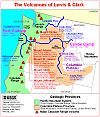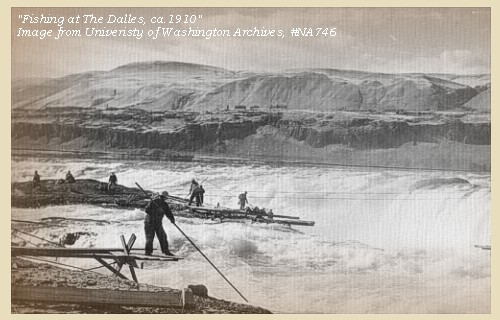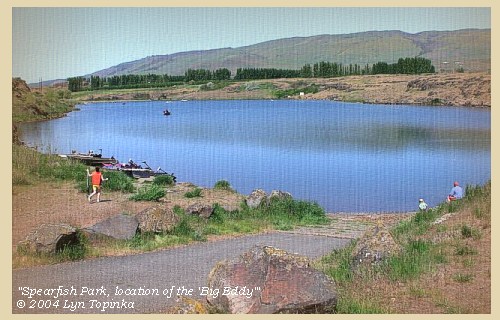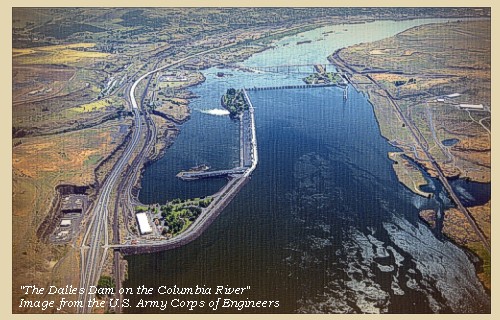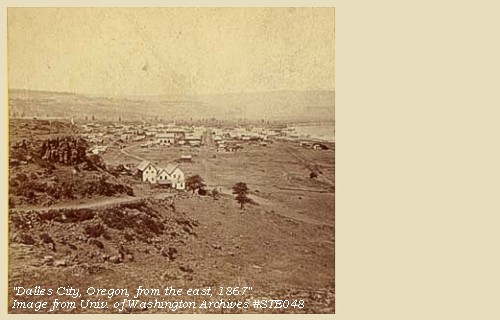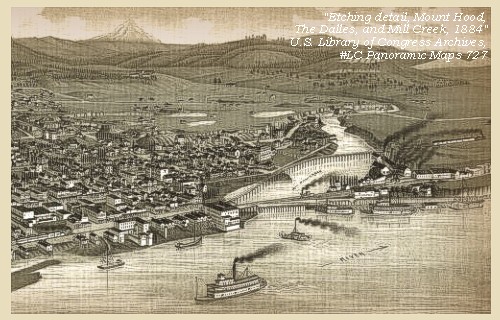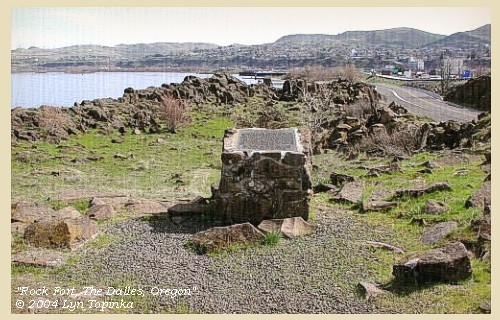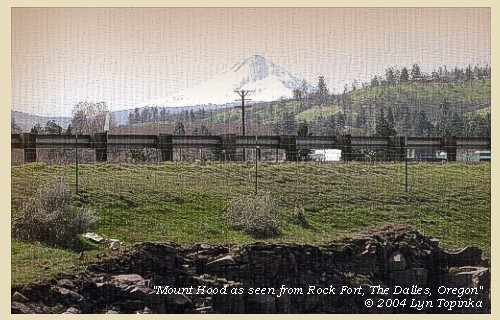The Volcanoes of
Lewis and Clark
Lewis and Clark
|
October 25, 1805 The Dalles - "Long Narrows" |
|
Home
The Volcanoes of Lewis and Clark Map of the Journey Volcanoes, Basalt Plateaus, Major Rivers, etc. The Volcanoes Mount Adams, Mount Hood, Mount Jefferson, Mount Rainier, and Mount St. Helens CALENDAR of the Journey October 1805 to June 1806 Along the Journey Pacific Northwest Maps - Columbia River, Volcanoes, Flood Basalts, Missoula Floods, Geology, etc. The Corps of Discovery The Journey of Lewis and Clark About the Reference Materials The Journals, Biddle/Allen, DeVoto, Gass, Moulton, Topo Maps, and others USGS Lewis and Clark Links Links to USGS Websites highlighting the Lewis and Clark Journey Resources Publications Referenced and Websites Visited |
PREVIOUS
October 24 "Short Narrows" |
October 25
The Dalles, "Long Narrows" Horsethief Butte, Five-Mile Rapids ("Long Narrows"), Spearfish Lake Park and "Big Eddy", The Dalles Dam, The Dalles (Oregon), Mill Creek, Rock Fort and Mount Hood |
CONTINUE
October 26-28 The Dalles, "Long Narrows" |
|
To the Pacific - October 1805
The Dalles - "Long Narrows" |
| Lewis and Clark's camp of October 24, 1805, was on the Washington State side of the Columbia River, near the location of today's Horsethief Lake State Park, just upstream of the "Long Narrows", and downstream from the "Short Narrows". |
| Friday, October 25, 1805 |
| We walked down with several of the Indians to view the part of the narrows [Five Mile Rapids ("The Long Narrows")] which they represented as most dangerous: we found it very difficult, but, as with our large canoes the portage was impracticable, we concluded on carrying our most valuable articles by land, and then hazarding the passage. We therefore returned to the village, and after sending some of the party with our best stores to make a portage, and fixed others on the rock to assist with ropes the canoes that might meet with any difficulty, we began the descent, in the presence of great numbers of Indians who had collected to witness this exploit. The channel for three miles is worn through a hard rough black rock from fifty to one hundred yards wide. in which the water swells and boils in a tremendous manner. |
|
|
|
Geology of Horsethief Butte and Vicinity:
Horsethief Butte and the surrounding Columbia River channel were carved out of basalt rock by floods following the last ice age. The basalt rock resulted from a series of lava flows which emerged from cracks in the earth's crust and blanketed the entire eastern Washington/Oregon region long before the coming of ice-age floods. When viewing the cliffs along the river, notice the stratigraphy highlighted by benches rising up the cliffs. Each of these benches, or layers, represents a different lava flow. Some lava flows were hundreds of feet thick in places. -- Washington State Parks and Recreation Website, 2002 |
| The three first canoes escaped very well; the fourth, however, had nearly filled with water; the fifth passed through with only a small quantity of water over her. At half a mile we had got through the worst part, and having reloaded our canoes went on very well for two and a half miles, except that one of the boats was nearly lost by running against a rock. |
| At the end of this channel of three miles, in which the Indians inform us they catch as many salmon as they wish, we reached a deep basin or bend of the river towards the right [Big Eddy], near the entrance of which are two rocks. |
| We crossed the basin [Big Eddy], which has a quiet and gentle current, and at the distance of a mile from its commencement, and a little below where the river resumes its channel, reached a rock which divides it. At this place we met our old chiefs, who, when we began the portage, had walked down to a village below to smoke a pipe of friendship on the renewal of peace. ...... On leaving this rock the river is gentle, but strewed with a great number of rocks for a few miles [Three-Mile Rapids, now the location of The Dalles Dam] |
| when it becomes a beautiful still stream about half a mile wide [location of today's city of The Dalles]. |
| At five miles from the large bend we came to the mouth of a creek [Mill Creek] twenty yards wide, heading in the range of mountains [Cascade Mountains] which run S. S. W. and S. W. for a long distance, and discharging a considerable quantity of water: it is called by the Indians Quenett [Mill Creek]. |
| We halted below it under a high point of rocks on the left; and as it was necessary to make some celestial observations, we formed a camp on the top of these rocks [Rock Fort Camp, The Dalles, Oregon]. This situation is perfectly well calculated for defence in case the Indians should incline to attack us, for the rocks form a sort of natural fortification with the aid of the river [Columbia River] and creek [Mill Creek], and is convenient to hunt along the foot of the mountains to the west and southwest, where there are several species of timber which form fine coverts for game. |
| "... we proceeded on down the water fine, rocks in every derection for a fiew miles when the river widens and becoms a butifull jentle Stream of about half a mile wide, Great numbers of the Sea orter about those narrows and both below and above. we came too, under a high point of rocks on the Lard. Side below a creek of 20 yards wide and much water, as it was necessary to make Some Selestial observations we formed our camp on the top of a high point of rocks which forms a kind of fortification in the Point between the river & creek, with a boat guard ..." [Clark, October 25, 1805] |
| From this rock, the pinnacle of the round mountain covered with snow, which we had seen a short distance below the forks of the Columbia, and which we had called the Falls or Timm mountain [Mount Hood], is south 43? west, and about thirty-seven miles distant. |
| "... passed great numbers of rocks, good water and Came to at a high point of rocks below the mouth of a Creek which falls in on the Lard Side and head up towards the high Snow mountain to the S W. this Creek is 20 yards wide and has Some beaver sign at its mouth river about 1/2 mile wide and Crouded with Sea otters ..." [Clark, October 25, 1805] |
| "... This little Creek heads in the range of mountains which run S S W & N W for a long distance on which is Scattering pine white Oake &c. The Pinical of the round toped mountain which we Saw a Short distance below the forks of this river is S. 43o W. of us and abt 37 miles, it is at this time toped with Snow we called this the 'falls mountain' or 'Timm' mountain ..." [Clark, October 25, 1805] |
| "... we cn Still See the round high mountain Some distance a head yet. we Camped below the mouth of a creek on a point of rocks on the Lard. Side. the country timbered back a little from the River ..." [Ordway, October 25, 1805] |
| The face of the country on both sides of the river above and below the falls is steep, rugged, and rocky, with a very small proportion of herbage, and no timber, except a few bushes: the hills, however, to the west, have some scattered pine, white oak and other kinds of trees. All the timber used by the people at the upper falls is rafted down the Towahnahiooks [Deschutes River]; and those who live at the head of the narrows we have just passed, bring their wood in the same way from this creek to the lower part of the narrows, from which it is carried three miles by land to their habitations. ...... |
| "... The face of the Countrey, on both Side of the river above and about the falls, is Steep ruged and rockey open and contain but a Small preportion of erbage, no timber a fiew bushes excepted ..." [Clark, October 25, 1805] |
|
|
|
The Camp - October 25 through October 27, 1805:
Lewis and Clark set up camp at "Rock Fort" during both their journey to the Pacific (October 25 through October 27, 1805) and their journey home (April 15 through April 17, 1806). |
| Home | Previous | Continue |
If you have questions or comments please contact: GS-CVO-WEB@usgs.gov
June/July 2004, Lyn Topinka
The Volcanoes of Lewis and Clark Home Page | CVO Home Page

